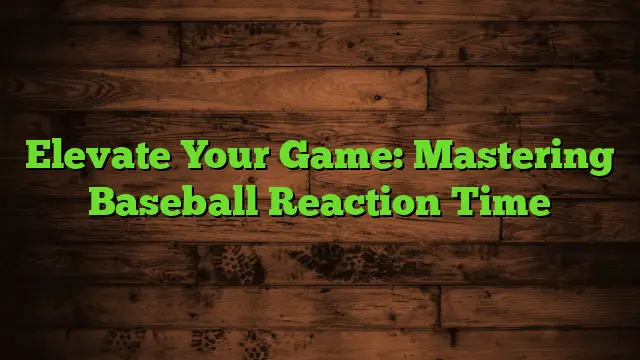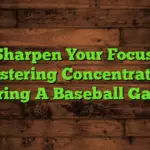In the high-stakes world of baseball, milliseconds can mean the difference between a strikeout and a home run. How to improve baseball reaction time is a question every player, from Little League to the pros, grapples with. This comprehensive guide will delve into the science behind reaction time, exploring proven training techniques, mental strategies, and nutritional considerations to help you shave precious seconds off your response time and dominate on the field. We’ll cover everything from visual training drills to advanced reaction time tests, ensuring you have a clear roadmap to achieving peak performance. Get ready to transform your game!
Baseball reaction time is the time it takes for a player to respond to a stimulus, such as a pitch or a batted ball. It’s a complex process involving visual perception, neural processing, and muscle activation. A faster
reaction time translates directly into better performance, leading to quicker hits, better catches, and more successful plays. Factors such as fatigue, stress, and even hydration can significantly impact reaction time.
Why Reaction Time Matters in Baseball
In baseball, where split-second decisions can change the outcome of a game, a superior reaction time is paramount. Pitchers need to react quickly to batters’ swings, fielders must react instantly to batted balls, and batters must react to the pitch’s trajectory and speed. A faster reaction time gives a player a competitive edge, allowing them to anticipate plays, make better decisions, and ultimately, perform at a higher level.
Key Components of Baseball Reaction Time
Baseball reaction time isn’t just about speed; it’s a multifaceted skill. It involves three key components: visual processing (how quickly you see the stimulus), neural processing (how quickly your brain processes the information), and motor execution (how quickly your muscles respond). Improving any of these components will improve your overall reaction time.
Measuring Your Baseball Reaction Time
Before embarking on any training regimen, it’s crucial to establish a baseline. Several tools and methods can measure reaction time, including online reaction time tests, dedicated sports performance testing equipment found in many training facilities, and even simple DIY experiments involving a ruler drop test. These tests provide quantifiable data, allowing you to track progress and adjust your training accordingly.
Training Drills for Improved Reaction Time
Numerous drills can specifically target improvements in reaction time. These often involve visual training exercises, such as tracking moving objects (tennis balls, baseballs) or focusing on specific targets. Plyometric exercises, like jump squats and box jumps, also improve neuromuscular response and muscle activation, enhancing overall reaction speed. These should be incorporated into a well-rounded training program.
Visual Training for Enhanced Reaction Speed
Visual Acuity
Improving visual acuity, the sharpness and clarity of vision, is critical. Exercises such as focusing on distant objects and then near objects, repeatedly, will train your eyes to adjust faster.
Peripheral Vision
Expanding your peripheral vision allows you to see more of the playing field, improving anticipatory skills. Drills involving tracking multiple moving objects simultaneously will greatly enhance this skill.
Neuromuscular Training for Faster Responses
Neuromuscular training focuses on improving the communication between your brain and muscles. Plyometrics, agility drills (like cone drills), and reaction ball training (catching and throwing reactive balls) are excellent methods to enhance neuromuscular efficiency and speed.
The Role of Mental Conditioning
Mental conditioning plays a significant role in reaction time. Stress and anxiety can significantly slow down your response. Techniques like mindfulness, meditation, and visualization can help calm the mind, reduce anxiety, and enhance focus, leading to improved reaction time.
Nutrition and Hydration for Optimal Performance
Proper nutrition and hydration are crucial for optimal athletic performance, including reaction time. A balanced diet rich in fruits, vegetables, lean protein, and complex carbohydrates provides the necessary energy and nutrients. Staying adequately hydrated is equally essential, as dehydration can impair cognitive function and slow reaction time.
Technology-Assisted Reaction Time Training
Technology has revolutionized reaction time training. Reaction-time training apps and devices are readily available. Many offer personalized training programs, real-time feedback, and progress tracking, helping athletes optimize their training to maximize reaction speed.
Advanced Reaction Time Training Techniques
For advanced players, incorporating more complex training techniques can further enhance reaction time. These often involve using specialized equipment, such as reaction-time balls, and implementing advanced drills that simulate game scenarios.
Common Mistakes to Avoid When Improving Reaction Time
Overtraining, improper technique, neglecting the mental aspect, and inconsistent training are common pitfalls. Progress takes time and consistency; listen to your body and avoid pushing yourself too hard, too soon. A gradual approach is crucial for long-term improvement.
Comparing Different Training Methods
Various methods exist to improve reaction time, each with its strengths and weaknesses. A combination of visual training, neuromuscular training, mental conditioning, and proper nutrition often yields the best results. It is often a matter of personal preference and identifying which methods best suit your individual training style and learning preferences.
Integrating Reaction Time Training into Your Overall Program
Reaction time training shouldn’t be done in isolation but rather integrated into your overall baseball training program. It should complement other aspects of training, such as strength and conditioning, skill development, and game strategy.
Long-Term Benefits of Improved Reaction Time
Beyond immediate on-field improvements, a faster reaction time can contribute to a longer, healthier baseball career. It reduces the risk of injuries by improving coordination and agility. It also fosters a more confident and effective playing style, enhancing overall athleticism.
Limitations of Reaction Time Training
While training can significantly improve reaction time, there are limits. Genetics plays a role, and individuals possess inherent differences in their natural reaction speed. However, even those with naturally slower reaction times can significantly enhance their performance through dedicated training.
Maintaining and Improving Reaction Time Over Time
Consistency is key to maintaining and improving reaction time over the long term. Regular training, even if it involves shorter, more focused sessions, is more effective than sporadic, intense workouts.
Frequently Asked Questions
What is the average baseball reaction time?
The average reaction time for professional baseball players is remarkably fast, often falling within the range of 180-250 milliseconds. However, this varies greatly depending on factors such as fatigue, age, and the specific demands of the play.
Can reaction time be improved at any age?
Yes, although improvements might be more substantial during younger ages when neural pathways are developing rapidly, reaction time can be enhanced throughout one’s life. While the potential for improvement may decrease with age, consistent training and a holistic approach can still yield positive results.
How often should I train to improve reaction time?
The frequency of training depends on your individual circumstances. Ideally, incorporating reaction time drills into your routine 2-3 times a week provides ample stimulus for improvement without causing overtraining. It is essential to allow for sufficient rest to allow your body to recover and adapt.
Are there any specific diets that enhance reaction time?
No single “magic” diet enhances reaction time. However, a balanced diet, rich in fruits, vegetables, lean protein, and complex carbohydrates, provides essential nutrients for optimal brain and body function. Staying well-hydrated is also paramount.
Can I use technology to improve my reaction time?
Yes, various apps and devices exist to improve reaction time. These often incorporate games and interactive exercises that challenge your reflexes. Many offer data-driven feedback, enabling you to monitor your progress and adapt your training strategy.
Final Thoughts
Improving your baseball reaction time requires a holistic approach that combines targeted training drills, mental conditioning, and proper nutrition. By focusing on visual training, neuromuscular exercises, and incorporating advanced training techniques, you can significantly enhance your on-field performance. Remember consistency is key; regular, focused practice is far more effective than sporadic intense bursts. With dedication and the right strategies, you can unlock your full potential and elevate your baseball game to new heights. Invest in your future by making reaction time training a core component of your routine. Start today and experience the difference a faster reaction time can make in your game. Whether you’re a seasoned professional or just starting, commit to the process, track your progress, and soon you’ll see significant improvements in your performance. The path to excellence in baseball starts with mastering your reaction time.





